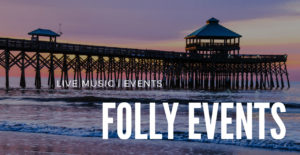How the City’s 10-Year Comprehensive Plan will guide Folly Beach through 2025
By Bill Davis | Staff Writer
Folly Beach is at a crossroads: Does it want to be more like Isle of Palms, or more like the “funky” Folly of yore?
In February, City Council will vote whether to accept the City of Folly Comprehensive Plan 2015 and its recommendations for what the Edge of America should become over the next decade.
While the 75-page document carries with it no regulatory power, it would serve as a guideline for a wide range of issues, from environmental to cultural to economic,
and beyond.
Aaron Pope, zoning administrator for the city, said that, “in an ideal world, all 38 goals in that plan would be achieved, because they represent the priorities in our community.”
The state-required plan was compiled through months of work by the municipal Planning Commission, City Council, administration and staffers, community groups like the Center Street Task Force, county and state agencies, and regional consultants.
But what’s really at the heart of the process was the question: How does Folly see itself growing?
Realtor LaJuan Kennedy represents the old guard on the Planning Commission, as she has lived on Folly for decades, and worked on the city’s first fledgling comprehensive plan years ago.
Kennedy remembers the days when the town rolled up its sidewalks after Labor Day, South of Broaders closed their summer beach homes and returned to the peninsula, and locals literally played games of touch football on Center Street.
Kennedy desperately wants to preserve “Funky Folly,” as it’s directly referred to on page 48 of the plan. But she doesn’t want to do it at the expense of homeowners showing pride in their residences and community.
Gone, she said, were the days when “hippies” slept on the streets in the 1970s. Gone, she said, should be the trash and weeds that still pop up and dominate some older homes and lots across the barrier island.
Hurricane Hugo and the huge jumps in real estate value that resulted in the years following doesn’t have to doom Folly to the bland ubiquity of pricier, stodgier IOP, says Kennedy, who believes a balance can be struck between “the old and the future.”
She says key to that would be not having a design and review process that dictates “cookie cutter” mini-mansions.
Planning chair Beth Saunders represents more of the new breed on the commission. She sees the same problems bedeviling the peninsula are finding a home on Folly: traffic, parking, balancing development and quality of life, and so on.
Saunders supports continued intelligent enforcement of city regulations when it comes to height requirements for new construction, as well as more uniform lot sizes, to make sure new construction doesn’t crowd out older, more established homes.
The draft comprehensive plan is available on the city website, cityoffollybeach.com. It also focuses on fundamental needs of the city.
Big-ticket items included a half-million-dollar second water main to augment water supply should there be a shut off on
James Island.
Two and a half dozen new police cruisers spread out over 10 years would cost $960,000. A $1.4 million influx to the fire department would bring a ladder truck replacement and a new fire engine.
Pope said the “400-pound gorilla” in paying for all the new equipment and goals would be the expected revenue from the accommodation tax, or A-Tax, and hospitality tax.
The comprehensive plan is also a treasure trove of information:
• In 2009, the A-Tax comprised nearly 22-percent of the city’s budget.
• By 2014, the A-Tax had grown to represent more than a third, 35.3-percent, of the city’s total budget, and that was before City Council voted to double the rate by December of that year.
• In 2000, the median value for a single-family home was $283,000. By 2013, it had risen to $607,000.
• With a median actual sales price of a residence of $450,000 in 2014, a household would have to earn roughly $150,000 annually to afford it, using a widely accepted home-to-earnings ratio.
Nestled into the plan was public feedback. Pope found it very reassuring that the number one concern of locals, among the issues they were asked about, was protecting the environment.
“The environment, here, is the golden goose,” said Pope, adding that Folly Beach’s most “exploitable” resource was Mother Nature. People want to come back for the beach, for kayaking, fishing, and so on,
he said.
Kennedy, donning her real estate agent hat, said many of those people who visit want to stay forever.
And hopefully the plan, all 38 goals and 75 pages, will help to preserve and burnish what makes Folly Beach … well … Folly Beach.

